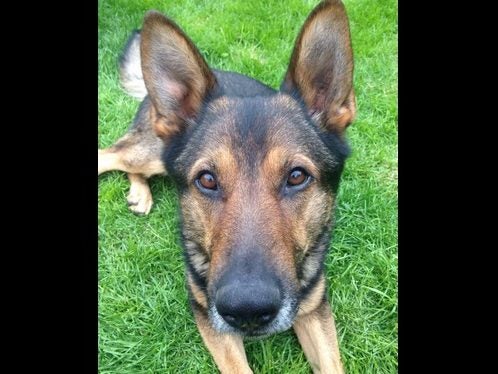
Two reporters were turned away from a youth court today after a judge limited the number of journalists allowed in so as not to “overwhelm” the teenage defendant.
Journalists were covering the case of a 16-year-old accused of attacking PC Dave Wardell and his police dog Finn (pictured) in October last year.
The incident made national headlines after the government backed a petition signed by 127,000 people calling for tougher sentences for people who attack on-duty police dogs and horses.
Of the five reporters arriving to cover the trial at Stevenage Magistrates’ Court today, only three were allowed to stay following a ruling from District Judge Joanna Matson.
Sam Meadows, chief reporter at the Hertfordshire Mercury, and a Ryan Hooper from Press Association were denied entry to the court.
Meadows told Press Gazette: “Just before the case was due to begin the District Judge called us in and told us she was only going to admit three members of the press.
“She said she was doing that to stop the defendant being overwhelmed and we asked what statute that was being done under but she didn’t tell us. It seemed like she was doing it under her own discretion.”
He said the group were given “two or three minutes” to decide between them who would stay. Journalists from South West News Service, The Comet and ITV remained in the court, with an agreement to share copy.
“I was quite annoyed about it,” said Meadows. “Obviously the press plays a really important role in the court system.
“Of course they need to take care when they are dealing with young people but given the massive public interest in this case, I don’t think barring members of the press can be justified at all.
“There were only five of us. Perhaps if 20 or 30 members of the press had turned up it would have been entirely justified. It wasn’t a matter of space.”
Meadows said that once he had returned to the newsroom he was told the judge had revoked the ruling barring his entry to the court.
But, he said:“It wasn’t very helpful for me because I was already back in the office.”
Hooper was permitted to sit in on the case more than 80 minutes later after protests to the Judicial Communications Office and the HM Courts and Tribunals Service.
By the time he was re-admitted the trial’s key witness had already given evidence and left – after the judge said she assumed the reporters had decided among themselves who could enter the courtroom.
The judge said: “I wasn’t excluding the person (Mr Hooper) in any way, I want to make that clear to you – but the court can control the number of people that can come in.”
The judge later allowed Hooper to access typed notes taken by a court associate, which offered a flavour of what the witness said, although without verbatim quotes.
Mike Dodd, PA legal editor at and co-author of McNae’s Essential Law for Journalists, said: “The District Judge was wrong to try to keep journalists out of court because she thought there were too many of them.
“Journalists have a statutory right to attend Youth Court hearings, and the law places no limits on how many might be there.
“This appears to be a continuing problems with Youth Courts – it is to be hoped that all Youth Courts will be reminded that journalists have the right to attend.
“In this case, the District Judge appears to have placed the defendant’s welfare above the requirements of open justice.”
Picture: Hertfordshire Police
Email pged@pressgazette.co.uk to point out mistakes, provide story tips or send in a letter for publication on our "Letters Page" blog
